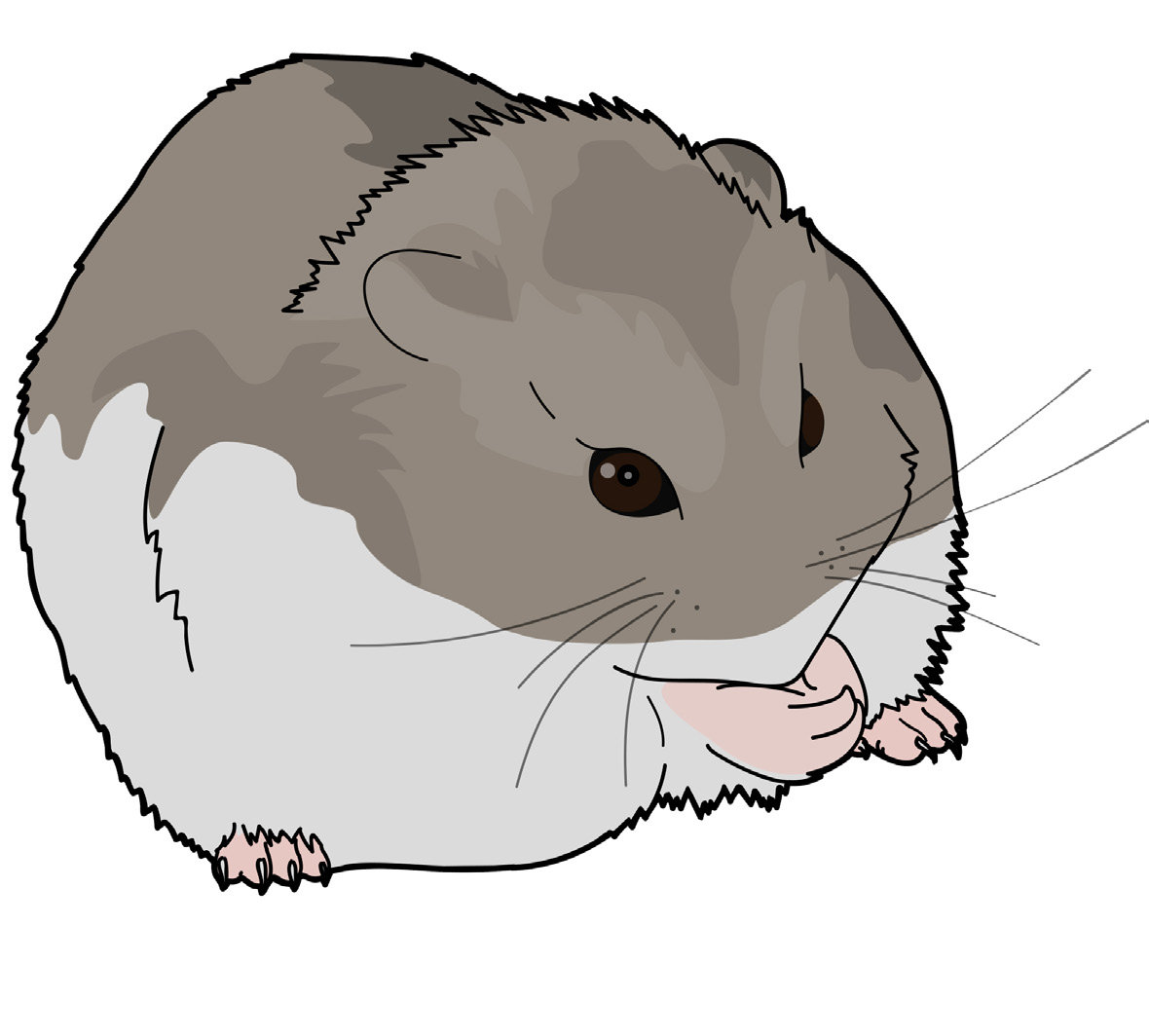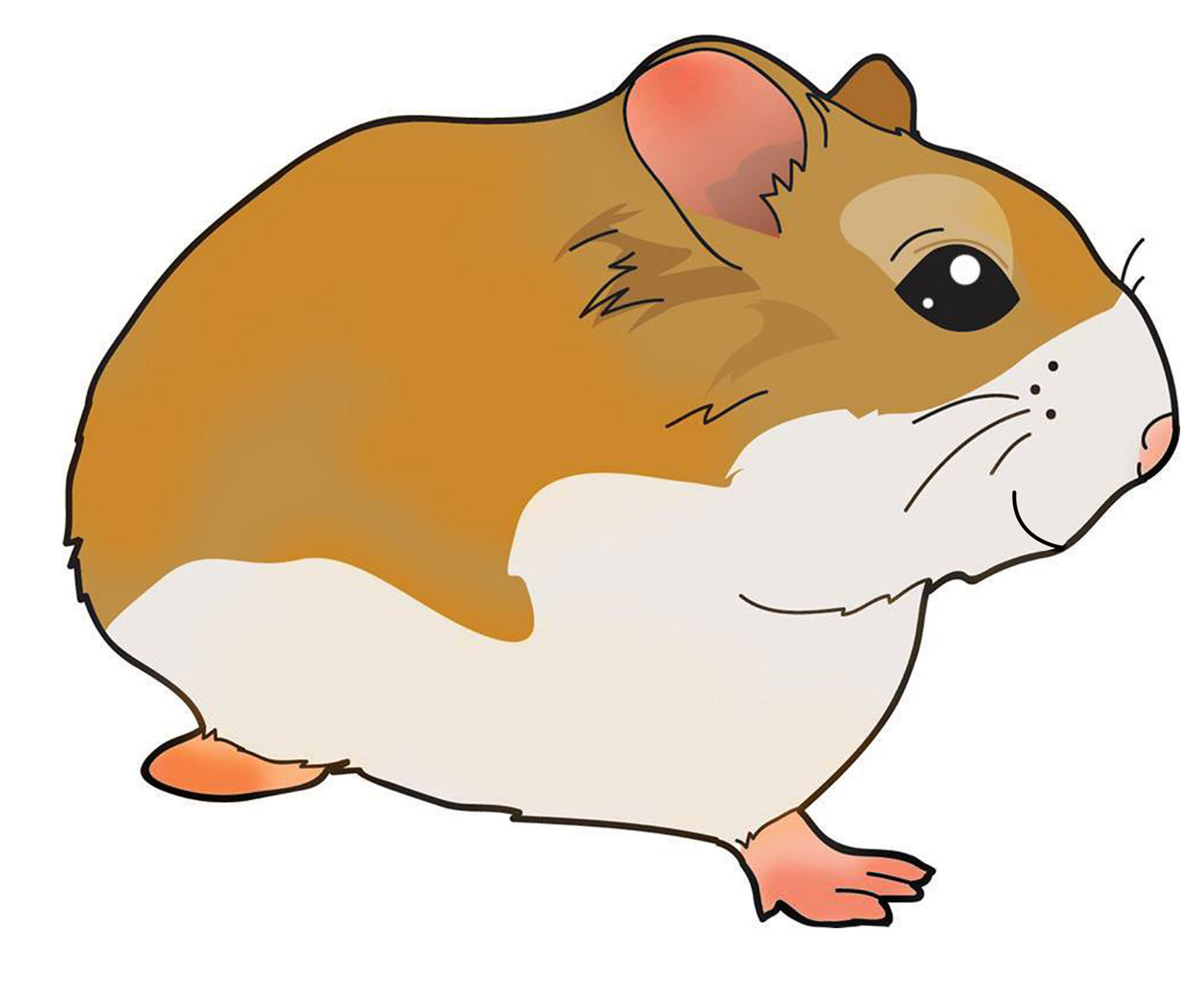Hamsters are the definition of “small but terrible.” These little fellas may be tiny in size, but they have an electric, active spirit. Whether it be running around in a hamster wheel or stuffing their cheeks with tasty treats, these adorable little rodents sure know how to pack a punch as there is a never a dull moment with them around.
Discovered in 1839 by a British zoologist named George Robert Waterhouse, who gave them the Latin name Cricetus auratus (golden hair), they were then domesticated in 1938. They are mammals that belong to the rodent family, and have large incisor teeth that continually grow. The word “hamster” comes from the German word “hamstern,” which means, “to hoard.”
Most hamsters inhabit semi-desert areas where they live in burrows (tunnels and chambers where they sleep and store food). While they have very poor eyesight, they have a keen sense of smell and excellent hearing.
Temperament: Hamsters are known to be solitary creatures as many hamsters, when housed together, may fight fiercely due to acute or chronic stress.
The nose knows: Hamsters also have poor eyesight and are color-blind; however, their sense of smell makes up for it as they have scent glands on their flanks. They use these to distinguish food and hamsters of the opposite sex. They are sensitive to high-pitched noises as they can hear and communicate in an ultrasonic range.
Lifespan and diet: Hamsters can live up to 2-3 years. They are omnivores, which means they eat both vegetables and meat. A normal diet will consist of one tablespoon of pellets or mixed grains and one slice or ample amounts of vegetables a day. Fresh clean water should always be provided through their drinking bottles, which require regular monitoring. They should be fed twice a day: once in the morning and once at night.
Bedding: To absorb their wastes and excretions, pine or cedar shavings aren’t recommended as these are abrasive for the hamster and can cause respiratory illnesses. Neither is it recommended to use newspaper, ‘fluffy bedding,’ corn cob, or cat litter. Instead, Aspen shavings and paper are recommended as alternatives.
Grooming: Hamsters usually require minimal maintenance as they are naturally tidy animals. Often, one may catch them cleaning themselves. It isn’t optional to wash one’s hamster as water will normally remove its skin’s natural oils, although long-haired hamsters may need to be brushed using a clean (unused) toothbrush to remove and prevent tangles. Bath sand can also be used to aid them in cleaning themselves up in order to get them smelling always fresh.
The Syrian

BASIC CARE
Housing:
- After 4-5 weeks of age, Syrians should be kept alone in separate cages
- Glass tanks with mesh lids and DIY plastic bin cages are some of the popular housings for Syrian hamsters
- Aspen, paper-based material,or hay (though this may not always be ideal—it can get tangled in the fur of long-haired hamsters or contain mites if taken from outdoors) are suitable for bedding
Feeding:
- As they are omnivorous, the most common items fed to them are seeds, nuts, grasses, and insects, with occasional portions of chicken or a hard boiled egg
- Avoid giving them acidic foods
- For nursing mothers, milky porridge, chopped hard boiled eggs, and scrambled eggs are some of foods they can eat.
Toys, Care, and Petting:
- Syrians are social and docile; they react well to frequent handling
- Not prone to urinating, or defecating much outside their cage
- They are energetic and need space to exercise. Wheels, log rolls, boxes, and tubes are some of the toys that may help it exercise and expend its energy
- Syrian hamsters are less prone to diseases and infections
Special Personality Traits
- Sweet and calm, they make great animal friends
- Most of them love to be held, and they can be tamed very quickly
- Very smart; some are escape artists
- Great cuddle-monsters who love yummy treats or nice tummy rubs
- Sometimes, the males help females giving birth by pulling out pups from the birth canal, cleaning the pups, and making sure the mother has enough to eat.
Campbell’s Dwarf Hamster

BASIC CARE
Feeding/diet
- As they are omnivores, they are commonly fed grains, nuts, and seeds that may be fortified with vitamins and minerals; they can also be given a regulated variety of fresh fruits and vegetables
- Campbell’s dwarf hamsters can occasionally eat mealworms or earthworms, boiled egg whites, and small pieces of clean, cooked chicken, as these are high in protein
- Avoid feeding them almonds, celery, unwashed produce, garlic, kidney beans, onion, potato tops, rhubarb, tomato, chocolate, cat food, and raisins
- After they reach 21 days of age, they become lactose intolerant and cannot digest milk
Health
- They have extremely poor eyesight and even worse depth perception
- They can develop tumors (both benign and malignant), as well as glaucoma.
Color Varieties
- Agouti colors – have off-white to cream colored bellies, 3 side arches, darker dorsal stripe, and the hair shafts have 2-3 colors on them- Normal (brown back with black tipping, orange line on arches, off-white belly, gray undercoat), black-eyed argente, opal, dark gray, argente, lilac fawn (with black), beige, blue fawn, blue beige
- Self-colors – same color over the entire body except for common white faults of moustache, chin, paws, and sometimes a white “zipper.” The hair shaft is the same color the entire length- Black with lilac fawn, silvering, albino, umbrous, chocolate, blue, dove, black-eyed lilac, dark beige, red-eyed lilac, champagne, black-eyed white, red-eyed white.
Pattern varieties: platinum, micro BEW microphthalamus; red-eyed mottled; red-eyed mottled anophthalmic; black-eyed mottled
Coat types:
- Satin – coat looks longer and tends to clump, giving it a greasy look and darkening the normal color of the dwarf hamster
- Rex – hair is sparse until the pup matures; hair and whiskers are curly
- Wavy – fur is wavy and the whiskers are curly
Special personality traits
- Campbell’s dwarf hamsters are sociable and can be kept in colonies if they are grouped together early (younger than 8 weeks)
- They establish a hierarchy, so one hamster will be dominant over another. The dominant hamster will chase and corner the submissive hamster, who will then usually stand upright in a submissive gesture. The dominant hamster often licks the belly of the submissive hamster. Even a pair of hamsters taken from a group to live together will re-establish dominance between them in their new home.
The Roborovski

Notes about the Roborovski
- They are known for their speed and have been said to run the equivalent of four human marathons each night on the average.
- In terms of appearance, their distinguishing characteristics are an eyebrow-like white spot and the lack of a dorsal stripe.
- They inhabit areas of loose sand and sparse vegetation and are rarely found in areas of dense vegetation and solid clay substrates
- Roborovski hamsters use water efficiently, which makes them suited to steppe and desert regions
- They are most active at dawn and dusk
- There are 10 variations known: Agouti, White-face, Husky, Mottled/Pied, Platinum, Head Spot, White-from-white-faced/Dark-eared white, and Red-Eyed
- Although it has been claimed that Robos are hypoallergenic, their fur has been associated with the development of asthma in previously asymptomatic owners.
BASIC CARE
Housing:
- Nesting material may be all-natural, padded with Bacterian camel or sheep wool
- A bowl of sand or chinchilla is recommended for their housing, but this should not be bird sand as that may contain sharp elements like broken seashells
- The sand can be kept clean by sieving or washing out with water only and drying
- Dust bathing is a vital part of a Roborovski hamster’s daily hygiene habits; this helps keep its coat shiny
Feeding/Diet:
- As they are omnivores they can have grains, vegetables, fruits, and plants, small amounts of meat, and insects
- Juveniles have a higher intake of food compared to their weight than adult hamsters
- Robos like to forage for food in their burrows
- They prefer eating small seeds (including millet)
- Larger and oilier seeds (such as sunflower seeds) should only be given as special treats because these contain too much fat
- For protein intake, mealworms or other insects (alive or dried) may be given
Toys/Petting
- A tunnel and run are great for Robos, which are climbers
- Their daily food allowance should be widely spread around the cage to support their natural behavior of foraging and stockpiling.
This appeared in Animal Scene’s February 2017 issue.






